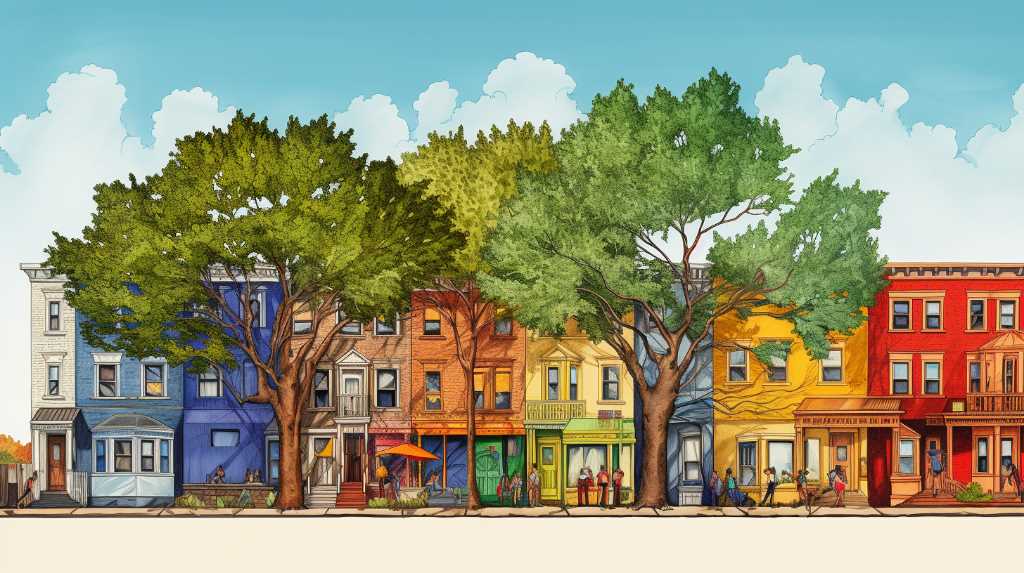In a world where green spaces are a luxury for some and a scarcity for others, the Tree Equity Score emerges as a game changer in the pursuit of environmental justice.
As cities glitter with the lushness of nature, others languish in concrete jungles.
This innovative tool, with its equity-first approach, aims to bridge the gap by identifying areas in need of trees.
Through community action and widespread tree planting efforts, the Tree Equity Score has the potential to transform urban landscapes and create a more equitable future.
Disparities in Tree Canopy Coverage
Disparities in tree canopy coverage persist across urban areas, leading to unequal distribution of green resources and limited access to shade and coolness in certain neighborhoods.
This imbalance in tree canopy coverage creates environmental inequities, as some communities are left without the benefits and services provided by trees.
The lack of trees in these areas exacerbates the urban heat island effect, where heat radiating from buildings contributes to higher temperatures.
This can have negative impacts on the health and well-being of residents, as they are deprived of the natural cooling effects and shade provided by trees.
Addressing these disparities is crucial for achieving environmental justice and ensuring that all communities have equal access to the numerous benefits of urban greenery.
Understanding Tree Equity
The concept of Tree Equity aims to address the unequal distribution of green resources in communities. It recognizes that some neighborhoods experience extreme heat more than others, often due to a lack of tree canopy coverage. Tree Equity prioritizes bringing trees to areas in need, with the goal of creating a more equitable distribution of green infrastructure.
Patterns of inequality in tree canopy coverage are prevalent across America, and the Tree Equity Score provides an equity-first approach to filling these gaps. The Tree Equity Score helps identify areas that need trees, and addresses are checked against the score to determine eligibility for tree planting programs.
Utilizing the Tree Equity Score
Utilizing the Tree Equity Score involves assessing the eligibility of addresses and leveraging the data to drive community action for equitable tree planting initiatives. By checking addresses against the Tree Equity Score, organizations and communities can identify areas that are in need of trees.
This data, along with the language and information provided by the score, can be used to facilitate community action and advocate for change. In the case of Pawtucket, over 150 trees have already been planted in residential areas and schools through collaboration with the city and Department of Public Works.
The Tree Equity Score has the potential to make a significant impact as it now covers all urban areas in America, providing over 260 million people with access to the tool. It is a powerful tool for advocating for change and securing funding for tree planting initiatives, ultimately leading to long-lasting connections and positive environmental impact.
The Impact of the Tree Equity Score
Having assessed the eligibility of addresses and leveraged the data to drive community action, the Tree Equity Score has made a significant impact in advocating for change and securing funding for equitable tree planting initiatives.
By identifying areas in need of trees through the Tree Equity Score, over 150 trees have been planted in residential areas and schools. This has been made possible through collaboration with the city of Pawtucket and the Department of Public Works.
Moreover, the Tree Equity Score now covers all urban areas in America, with 80% of the population having access to the tool. With over 260 million people being able to utilize the Tree Equity Score, it has become a powerful advocacy tool in the fight for environmental justice.
Through its efforts, long-lasting connections have been made and positive impacts have been achieved through targeted tree planting efforts.
The Future of Tree Equity Score
Moving forward, the expansion and refinement of the Tree Equity Score will continue to shape the trajectory of environmental justice efforts.
With the Tree Equity Score now covering all urban areas in America and 80% of the population having access to it, the tool has the potential to make a significant impact.
The future of the Tree Equity Score lies in its ability to advocate for change and secure funding for tree planting initiatives in areas that need it the most.
By identifying areas that lack tree canopy coverage and using the score to determine eligibility, communities can take action to address the disparities and improve the quality of life for their residents.
Collaborations with cities and organizations like the city of Pawtucket and the Department of Public Works have already resulted in over 150 trees being planted, but the potential for long-lasting connections and positive impact is immense.
The Tree Equity Score has become a powerful tool in the fight for environmental justice, and its future holds great promise.
Conclusion
In conclusion, the Tree Equity Score has emerged as a game changer in addressing disparities in tree canopy coverage and promoting environmental justice.
By identifying areas in need of trees and facilitating community action, this innovative tool has the potential to create lasting connections and positive impacts through widespread tree planting efforts.
With the future of the Tree Equity Score looking promising, it is clear that the phrase ‘planting the seeds of change’ aptly describes the transformative potential of this equity-first approach.
